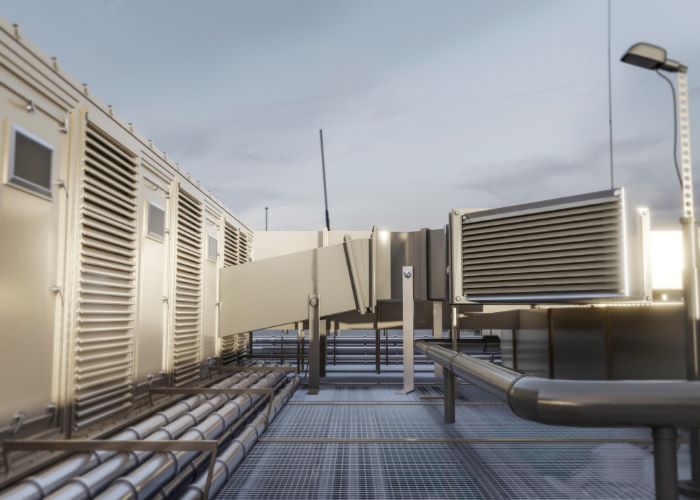Hospitals are places where all kinds of precautions must be taken regarding the management of indoor air such as ventilation, filtration, heating and cooling. Before moving on to clean air solutions, there are various precautions and control systems that can be preferred in hospitals that require maintenance to prevent viruses that will be transmitted through the respiratory tract. It is possible to be in an environment where clean air is constantly dominant with efficient ventilation systems. Hospital ventilation systems are very important for cleaning dirty air, keeping the temperature and humidity in the environment stable, and especially for taking precautions against airborne contaminants.

Ventilation systems not only provide continuous clean air in hospitals, but also remove odors, moisture, bacteria, chemicals and various gases from the environment. In fact, some areas require special ventilation systems to ensure staff and patient safety.
Medical equipment in hospitals and healthcare institutions can be sensitive to heat and humidity. Proper air control is essential for proper storage of this equipment. It is possible to provide filtration of the environment with ventilation systems, which form the basis of maintaining air quality under appropriate conditions.
Ventilation is a need that hospitals need to take into consideration both in terms of air pollution control and energy saving. It is of great importance for the safety of both hospital staff and patients, as well as the technical equipment and machinery used.
In environments such as hospitals, different climates can occur in the environment due to the presence of a wide variety of microorganisms together. For this reason, regular air inflow and outflow in hospitals is essential for hygiene and health. Hospital ventilation systems that protect air quality and balance temperature and humidity conditions are very effective in preventing airborne pathogens from infecting patients, medical personnel and visitors. Hospital ventilation systems, which are designed to determine variables such as humidity and temperature and bring the environment to the maximum level needed, ensure that hospitals are sustainable, healthy living spaces.
Each section of the hospital, such as hospital wards, laboratories, intensive care unit, operating room, pharmacy, corridor, morgue, visitor rooms and patient dormitories, has different ventilation and air conditioning needs. With the customizable rating options of hospital ventilation systems, it is possible to create separate temperature, humidity and ventilation standards for each room.
Although comfort is the priority in public areas, ventilation systems are ultimately preferred in hospitals for safety and health reasons. Hospital ventilation systems, which minimize the risk of infection due to sharing the same environment with patients coming for treatment, are of great importance in controlling harmful microorganisms.
Infection is a known condition in hospitals. Since infectious pathogens are more common in hospitals, they can be transmitted to other patients through particles and dust in the environment. It is possible to protect against allergens and infection risks in the environment with ventilation systems that provide air filtration.
Some laboratory and medical equipment may require lower ambient temperatures. For example, the temperature in rooms where the MRI device is located is cooler than other rooms in the hospital. Thanks to the cooling and heating features of ventilation systems, you can easily control each room and increase service quality.
Large buildings such as hospitals need to save energy consumption. It is very difficult to create separate air conditioning and conditioning conditions for the entire building. It is possible to give different commands to the ventilation systems via a central unit to control the air flow to multiple areas.
In environments such as hospitals where comfort is at the forefront, ventilation systems produced with low noise technology are preferred. An effective ventilation system in hospitals includes technical features such as filtering, appropriate temperature, humidity and air pressure adjustment. Using separate air systems and quality air filters for different sections of the hospital is the primary requirement of health centers.
Some of the areas that require separate ventilation systems in hospitals can be listed as follows:
Operating rooms are places where the possibility of infection is high in terms of fresh air quality. Standard ventilation may not be sufficient for the operating room. It is also important to maintain the humidity level of the operating room, which requires a relative humidity of approximately 60%. Otherwise, it may not be possible to protect patients from the negative effects of air currents as much as necessary.
Intensive care units, one of the environments where patients are most vulnerable, are areas that are carefully monitored for their components such as air flow, temperature and humidity values. For this reason, intensive care units are among the areas where ventilation systems are needed the most in a hospital.
When it comes to ventilation systems, it may be thought that hospital laboratories are not as needed as the main buildings. However, it is very important to use ventilation systems to prevent the spread of odors and fumes released by chemicals into the hospital.
Ventilation systems are needed in patient rooms to combat infections that may be transmitted by visitors and to improve the air quality of the environment. Although there is not as much human traffic as in the main hospital buildings, ventilation is a necessity for patient rooms due to the presence of toilet areas.
By choosing ERF Group ventilation systems, you can turn a quality machine into a long-term investment with regular periodic maintenance. You can come to our ERF Group branches to get more information about hospital ventilation systems, you can contact our company using our contact numbers or Whatsapp line.